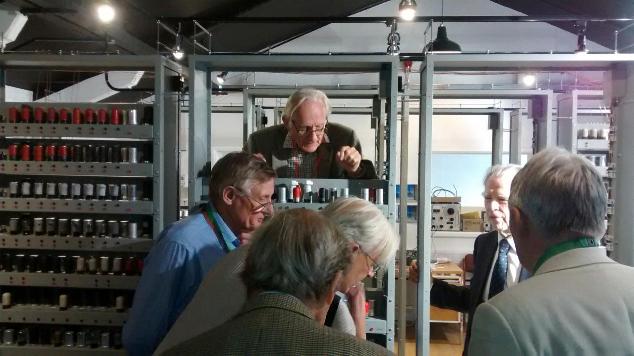
| Resurrection Home | Previous issue | Next issue | View Original Cover | PDF Version |
Computer
RESURRECTION
The Bulletin of the Computer Conservation Society
ISSN 0958-7403
|
Number 67 |
Autumn 2014 |
|
|
(Commonwealth Edition) |
||
MOSI Matters
It is with a heavy heart that we have to report that the authorities at the Manchester Museum of Science and Industry have decided to terminate the Hartree Differential Analyser Project and the Pegasus Peripherals Project as they no longer fit in with the Museum’s future plans. We understand that the Computing Gallery will be closed. A sad day for us all, especially for Charles Lindsey, Brian Russell, Dave Wade and the other team members.
ICL 1900 Group – Delwyn Holroyd
Alan Thomson has been busy over the summer organising the September lecture on the origins of the 1900 Series.
With efforts underway to run CME/G3 on the 2966 there is currently some overlap between the activities of the two projects. I will report here the 1900 software aspects.
The George 3 executive emulator has been enhanced to work with the full range of disc types supported under CME and to emulate the dual video screen CME operators’ console. This has enabled me to create a loadable CME system disc image.
We have a compilation listing and binary dump of EXG3, the CME G3 executive, but the compiled configuration is not right for our 2966. Bill Gallagher has managed to produce a cleaned copy of the executive GIN compiler GINX/522 and is now working on extracting the source from the compilation listing with the aim of re-compiling the exec with a suitable configuration. The only problem may be if vital source code is hidden from the listing with #LIS directives. All will not be lost as we do have the binary dump, but it will make the process somewhat more challenging.
The other issue is that George requires a dual screen OPER (Operating Station), and we don’t have one! However it looks fairly straightforward to patch George to make use of the primary screen only. The second screen is normally used to display older messages, but these can also be shown by command on the primary screen. We are hoping that the CME executive extracodes to drive an SCP or OPER-M are the same, although so far we haven’t been able to unearth any documentation. If any reader has a copy of the CME executive specification, please get in touch.
Tony Sale Award – Peta Walmisley
The award ceremony for the 2014 Tony Sale Award will be at 18:30 on Thursday 6th November at the BCS in London’s Southampton Street. A buffet reception follows at 19:30. All CCS members are (of course) invited.
EDSAC Replica – Andrew Herbert
The project passed an important milestone at the beginning of August – over 70 of the total of 142 chassis have now been constructed, taking us to the halfway point. The work on the EDSAC gallery is essentially complete with all the racks erected, the power supply built and commissioned by Alex Passmore and Tom Toth and the overhead wiring gantries on each row of racks installed by Don Kesterton. The surrounding barrier is substantially complete, awaiting the top rail and information panels to be fitted.
The power supply is connected to the TNMoC distribution panel as a temporary measure – longer term a dedicated feed is required to supply the estimated 10-11KW necessary for EDSAC. This requires a new cable to be laid from the Bletchley Park substation and therefore the permission of the Bletchley Park Trust, which has yet to be granted.

|
Commissioning of chassis in their final rack positions commenced with a working party on 28th August following a volunteers’ meeting the day before. We are perhaps in a more fortunate position than the pioneers in that we have been able to use modern electronics and test gear to check chassis individually and we have the benefit of a logic level simulation to validate the overall architecture. We also know the original machine (eventually) worked.
The clock pulse generator and five of the seven digit pulse generators are now working in situ and little difficulty is expected with the remaining two thanks to the efforts of Chris Burton, Peter Lawrence and John Sanderson. The store addressing and coincidence chassis are all in place and will be commissioned next by John Pratt.
A team comprising Peter Haworth, Don Kesterton and a newly joined volunteer Les Ferguy are starting to commission the large number of storage regeneration units constructed to date following procedures established by Chris Burton. Nigel Bennée has designed a simple PCB microcontroller circuit that can be connected to a chassis 01 to simulate a delay line providing us with a useful testing aid and interim store technology.
On the design side Nigel Bennée has now mapped out the bulk of the “Computer” (i.e. the arithmetic unit); James Barr has completed the design of the Order Decoding System and is now moving to the design of Main Control (stage 1 and 2); John Pratt is working on the transfer tank and sequence control tank systems. (The transfer tank is used to copy data from the output bus back to the input bus, the sequence control tank is the program counter). A team of “wiremen” volunteers, Tom Toth, Dave Milway, Martin Evans, John Loker and Peter Isley, are busy building chassis to the emerging designs.
Bill Purvis has updated the logic simulation to reflect improved understanding of how EDSAC worked as we complete more circuit designs. In addition to his ELSIE simulator Bill is able to load the simulation on to a Field-Programmable Gate Array (FPGA) development system and execute EDSAC programs. Following the most recent updates the simulator has successfully run some of the more substantial example programs collected by Martin Campbell-Kelly. Bill also continues with the mechanical engineering of the teleprinter and the paper tape reader, interfacing both to the FPGA initially before developing the necessary EDSAC circuits.
Andrew Brown and John Sanderson have continued working on initial orders. Andrew has prototyped the uniselector unit. John has wired up the initial orders and is investigating how the unit should inject the orders into store.
Peter Lawrence has been investigating clock and digit pulse distribution circuits and is working on the design of a suitable distribution unit chassis.
Peter Linington continues to refine the nickel delay line prototypes for both short and long tanks and hopes to have a final design suitable for mass production shortly. The coffins that will hold the delay lines are designed and await construction.
The project manager continues the production of mechanical components as required (tag strips, transformers) and has just had RF coil formers added to his list. He has also begun the task of attaching Traffolite labels to identify chassis.
Alan Clarke, as project stores keeper, continues to locate and procure components as required with great success and keep track of what is where and in what state of construction/test.
We still have a number of engineering topics to investigate: the clock monitor unit, the three oscilloscope unit and the operators’ desk/control panel. Chris Burton is looking at the first two of these.
Dave Allen continues to produce excellent videos on the progress of the project and the work of individual engineers. He is now outlining a brief summary video to be shown in the EDSAC gallery when the machine is unattended, a longer “documentary” video about the reconstruction and a possible third video on EDSAC principles of operation.
The current task of the project trustees is to complete fundraising. To date about £170K of the total £250K budget has been raised from donors and most of that has now been spent on purchases and fitting out the gallery. A further injection of money is needed before the project can start manufacture of the delay lines for the store and make a start on developing educational materials to support the EDSAC replica as a museum exhibit.
An event is in preparation for Wednesday 26th November to celebrate the completion of the EDSAC gallery and the start of the commissioning phase of the project. It is hoped this event will also help publicise the project and help with fundraising.
Software – David Holdsworth
Leo III RescueThe Leo III software rescue continues to make good progress.
We now have other members of the team running the emulation software on their own machines, and their recollections of working with real Leo machines are proving invaluable. Current focus is on the master routine generator program, which was used to customise a master routine to a particular machine configuration, a practice very common in the 1960s.
There is real prospect of being able to run a genuine master routine with genuine Leo III software. We have several utility programs which have not yet been processed.
The complexity of the Leo III software system continues to amaze me, especially the way in which the Leo veterans take it in their strides.
An object lesson
We recently found a bug in our emulator, which arose through misunderstanding the manual. It was only detected because we encountered code which made no sense according to my original understanding of the manual. Discussion with veterans cleared up the issue. This illustrates the value of getting it all working while veterans are around.
Elliott 803/903 – Terry Froggatt
On 4th June, Andrew Herbert and I visited the Science Museum’s site at Wroughton. We were able to inspect and photograph their three 920As at close quarters. One of these was in the military green casting, like those I’ve used in the past, but the other two were in industrial cabinets similar to a 803. Conversely two of the control panels were like the tall familiar one at TNMoC, whilst one was much sleeker. We also saw their 903, but they only have the CPU rack containing the usual cards and 8K store, they did not have the desk or power supplies. We did not manage to see the 920B donated by Paul Rayner, shown in Computing 19th November 1987, nor did we manage to catalogue the many paper tapes within our allocated hour, so there is scope for another visit.
The 61-way cable for the spare 903 display unit is now completed: soldering 61 wires in close proximity was not as difficult as I was expecting. The display unit, with cables, is now in Cambridge, where there are two 903s. Thanks are due to the CCS for funding the expensive plug and socket needed to bring this useful diagnostic tool back into use.
|
|
Harwell Dekatron – Delwyn Holroyd
An issue with the timer relay in the power supply brought the machine down some weeks ago, but was easily fixed. Apart from a few trigger tube and store anode resistor problems the machine has been in full operation.
Tony Frazer has rejoined the project team and has done a lot of work to weed out sticky Dekatrons. He is also working on new Dekatron spinners.
The machine featured on the BBC’s TechTent radio program which was broadcast live from TNMOC last week, although it was unfortunately described as a rebuild!
ICL 2966 – Delwyn Holroyd
The addition of a new member to the project team has allowed work to start on restoring one of the four GTS2 tape decks. All the air tubing was rotten and needed replacement. The reel motors have been completely rebuilt with new bearings and magnets re-glued to the case. New drive belts were obtained for the pneumatics system. We have been able to load and run a tape successfully but we are now having problems with the air compressor seizing up. There is also a problem in the electronics for the ICL adapter which converts the deck’s native interface to the ICL 2900 Peripheral Interface, and the state of the formatter electronics is as yet unknown.
The central units continue to run well although there is now a CUTS failure on one of the store control boards to do with hamming generation.
Design work is progressing well on a disc emulator which will allow us to run a real operating system. Our initial target is 1900 operators executive under CME, closely followed by George 3. There is more discussion of this in the 1900 working group report. The unit will emulate four EDS80 drives with backing storage provided by a micro-SD card. The disc interface is handled by an FPGA with dual ARM cores running at 667MHz.
The mains distribution for the system has been overhauled to correct a number of problems with circuit ratings and connector types. New circuits have been added for the tape decks, lineprinter and for the Trimetra DY which is located alongside. We are now able to load VME on the Trimetra.
IBM Hursley Museum – Peter Short
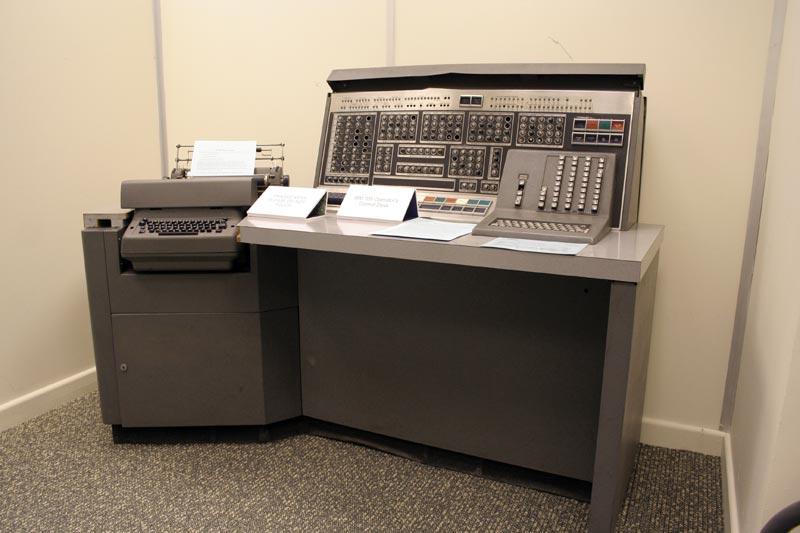
|
The big acquisition for the museum recently is the Royal Army Pay Corps IBM 705 console, together with one IBM 727 tape unit, an 024 card punch, 056 card verifier and a 3350 disc drive from their S/370 model 158. These are on long-term loan from the Adjutant General Corps at Worthy Down.
Sadly we are missing many bits, such as the table tops and card weights for the punch and verifier. The innards of the tape unit were removed at some point and we have an interesting pile of bits and an empty case – mega Meccano! We had an interesting time getting the 3350 indoors, requiring us to remove all the door brackets to just squeeze through the doors, and the HDAs to get the weight down. There are more pictures at hursley.slx-online.biz/705_story.asp.
There have been a few small donations including a PC and PC-XT. The PC emitted lots of smoke and now smells bad, the XT is just dead, so static exhibit potential only (once the smell goes!)
In May we learned of a warehouse find in the US consisting of a large number of S/360s, S/370s and peripherals. This was briefly reported in Resurrection 66. Amongst the hardware is an S/360 Model 40, which was developed at Hursley and was the first S/360 to be powered on. We expressed our interest in getting this back to the UK, and found a sponsor who might pay for shipment. Since then the people charged with disposing of this stash have stopped communicating so we don’t know what is happening. Hopefully they’ll resurface soon.
Also in May, the museum loaned a number of artefacts to Barclays Bank for their 50th mainframe celebrations. We also had a visit from an employee of the National Air Traffic Services, who rescued a S/360 Model 65 when they were discontinued many moons ago. He plans to get it working when he retires!
Ferranti Argus 700 Project – Peter Harry
The important news regarding our Argus 700 Restoration Project is that the Bloodhound simulator is now working. The breakthrough came once we identified the last faulty card in the A700.
Our vulnerability for the future running of the Argus 700 has been brought in to sharp focus. We started with four original CDC Wren I Winchester discs three of which have failed this year. The one remaining disc is not going to last which is probably a bit of an understatement based on the evidence. The CDC discs are circa 1985 and have a life of 20,000 hours or five years before a “return to manufacturer for a refurbish” is required. Our solution is to replace the Argus 700 FINCH disc controller with a SCSI controller and use more modern SCSI discs in place of the CDC Wren. That is the first step; the second step is to replace the SCSI disc with a commercially available solid state SCSI disc emulator. The planned change of technology will not detract from the physical presence of the original CDC disc and its controller to maintain an historical completeness. The change of disc technology is a necessary ‘behind the scenes’ development. The feasibility of using SCSI technology has been proven by the Swiss in the mid 1990’s, who implemented a SCSI alternative to the CDC Wren on the Argus 700, so we know it works.
Work also continues to keep the Argus 700 with its I/O and display systems working. Tasks have included the repair of a Farnell G5 120A power supply where, once again, a RIFA filter capacitor failed in spectacular style. One particular problem which has given us problems over many months is the reliability of the Ferranti CHARGE display system; random error messages from CHARGE on the FT81 system terminal were not uncommon. We are now hoping that we have got to the bottom of this after finding a loose +5V terminal to the CHARGE display system. A significant amount of current is drawn by the CHARGE system illustrated by the output voltage of its G5 120A power supply being adjusted to 5.6V to achieve +5V at the CHARGE chassis. A loose terminal with probable oxidisation on the cable lugs was not helping and introduced a voltage drop on the power cable. After treating and reconnecting the terminal the CHARGE display system has been stable.
CHARGE faults do conspire to frustrate us. On a recent run-up of the simulator we noticed that one of the four display consoles was repeating display data three times. It looked like a vertical sync was three times the frequency it should be. We do know the fault is due to a store card used by the CHARGE system and not the monitor. Time will tell if this is due to a component failure or a poor connection for a socketed device. Unfortunately we do not have a spare store card.
We do have some system units for which we have no spares, one being the Ferranti FT81 system monitor. The FT81 remains in use on the simulator and is not available for our bench test rig. To resolve the problem and be able to view system messages from the Argus 700 test rig we have configured a laptop with a VT100 emulation package, a serial to USB adapter and an adapter cable to convert the serial FT81 socket wiring to standard serial 9 pin D Sub wiring. This set-up works well which also gives us a fall-back position should our only FT81 fail. I suspect this arrangement will not support all the Ferranti terminal control sequences.
In looking forward to the autumn we will be focused on our disc replacement plan. We already have some of the components required, but not all. We have a loan of an Argus 700 SCSI disc controller and have also sourced a couple of Seagate Hawk ST31200N SCSI discs. Missing though is a Ferranti SCSI/QIC02 controller (MS221) and the Ferranti disc configuration software, 7UDM72. Any information on the availability of these missing items will be very welcome.
Manchester Baby – Chris Burton
The computer at MOSI continues to be demonstrated three or four days per week by the excellent team of volunteers. At busy times of the year they typically have 30 to 40 conversations with the public on each demonstration day, though occasionally as few as ten on days when visitors are attracted to other special events in the same part of the museum.
Over the last quarter the machine has suffered several faults, more or less difficult to diagnose. These are nearly all due to failing valves, either EA50 miniature diodes, or EF50 pentodes, and very frequently due to heater-cathode shorts or loss of emission. Another class of fault is the delicate settings of the main CRT store drifting out of adjustment, requiring patient setting-up again. Currently there is only one intermittent fault known, which clears itself up after ten minutes running.
Use is being made of a good simulator of the machine running on a PC with a large screen. This is invaluable for explaining the machine when for example only one volunteer is in attendance, when our rule is that the replica may not then be switched on. Similarly, the simulator is useful while other volunteers are fault-finding. It was also part of a highly successful weekend when visitors were invited to “Program the Baby” after an introductory learning session.
Analytical Engine – Doron Swade
The Leverhulme research project formally started 1st June after the successful recruitment of the fourth member of the team which is now at full strength.
In the last months the team has made progress on four fronts:
| (1) | the formulation of a rigorous mathematical description of the method of differences as implemented by Difference Engine No. 2, |
| (2) | other technologies available in 19th century have been explored as counter-factual alternatives to Babbage’s mechanical logic, |
| (3) | progress made on simulation, |
| (4) | exploration of Babbage’s Mechanical Notation – the language of signs and symbols that he used to describe the calculating mechanisms and as an aid to optimise the designs. |
The Science Museum has scanned the remaining manufacturing drawings for Difference Engine No. 2 (DE2) and the set of 256 modern piece-part drawings is now complete in digital form. There remain some minor issues of sharpness in scans in a few of the original 19th century archive drawings where the Notations are particularly fine or obscure. This is being addressed by the Science Museum’s photo studio and archivists whose help and cooperation have been substantial.
Though the problematic drawings are for DE2 they have significance for the Analytical Engine project: intimate knowledge of the already-constructed DE2 is being used to decode the Notation. Knowledge of the Notation will then be extended to the Notations for the Analytical Engine with a view to establishing whether they contain essential design information not included in the original design drawings. Answers to this question will give strong clues as to how Babbage used the Notation – whether he primarily thought in logical symbolic terms and then implemented this in mechanisms, or whether his mental language was essentially mechanical and the Notations were used as retrospective description. Or perhaps a continuous loop between the two. The role of the Notation in Babbage’s design process is a key question in this phase of the project.
In summary: the project is thoroughly under way. It is early days and we are greatly encouraged by progress so far.
Bombe Rebuild Project – John Harper
In order to protect and preserve the Bombe Rebuild in the long term we have now created a legally binding Trust. The main objectives are to keep the machine in good order and make it available for regular demonstrations.
We have recently successfully completed our fifth GCHQ challenge. This time it was from GCHQ Scarborough. This was part of their 100th anniversary since being established early in WW1; albeit it was not then the GCHQ we would recognise today. The challenge took place as a supporting exhibit to a celebratory lecture give by the GCHQ historian.
The Bombe Rebuild itself has now been running almost every day for the last seven or more years. We have never experienced any major problems during that time and have never been in a situation when it has not been available for visitor demonstrations or filming except where planned maintenance has taken place. However there have been signs of wear to a few mechanical parts and currently replacements are being made by team members.
Those who are interested in the detail of how the Bombe is used to find Enigma settings are recommended to read a new publication Demystifying the Bombe written by Sir Dermot Turing, the nephew of Alan Turing. Dermot has spent many hours with members of our team studying and operating the Bombe and Checking Machine. We are very pleased with the way that Dermot has taken our technical input and turned it into a very readable publication. There is only so far that one can simplify a complex subject but Dermot has struck an excellent balance with which we are very pleased to be associated. The paperback is currently available in the Bletchley Park Trust shop. It is listed on Amazon but at the time this report is written, it is said to be out of stock. No doubt this situation will change in the near future. The ISBN is 978-1-84165-566-6 1/14
Some time ago I reported that the Bombe Rebuild website would be updated as it was well out of date. As it happened this did not go according to plan. The ISP where it was held did not provide the service that we needed so it had to be transferred. It is now at www.bomberebuild.webspace.virginmedia.com. It will now be updated in the new location in due course.
ICT 1301 – Rod Brown
A YouTube video has been proposed showcasing the work at Buss Farm, working title: The First Ten Years. It will be produced by the very members who made those ten years happen.
The 50th anniversary of the ICT 1900 Series has been celebrated by lots of people “who were there” and a great many (such as your humble editor) who were not. Our well-attended September meeting in London covered the pre-history of the range and how it became ICT/ICL’s most successful computer. Fujitsu have made a video and published an article in their online house magazine. CCS stalwart Alan Thomson has been working tirelessly on these matters for many months and the success of these events is in no small measure due to him. Well done Alan!
101010101
It is sobering, however, to discover that CCS itself is almost exactly half as old. Our London October meeting will be/was preceded by a lunch for the various movers and shakers, past and present who have toiled over the last quarter of a century to make the Society what it is today. Resurrection 1 reported that we had 160 members. We now boast over a thousand! Not bad for our little society!
101010101
But the big news in this edition is the opening on 25th October of the London Science Museum’s new Information Age gallery. Dedicated to 200 years of information and communications technology, it features inter alia, two iconic mainframe computers illustrating the cold war divide of the 1960s – the Russian BESM-6 and the Control Data 6600, itself approaching its half-century in December this year. There will also be a book to go with the exhibition. Details at tinyurl.com/infm-age, Review (with luck) in Resurrection 68.
101010101
Arguably even bigger news from the Science Museum, is that the Mathematics Gallery (what we probably think of as the Computer Gallery) is to be completely reworked. A spectacularly generous donation of £5,000,000 will enable this transformation to take place. The donation is from David Harding, founder of hedge fund company Wilton Capital Management
The new Gallery will reopen in late 2016. Planning is at an early stage as yet, but we are given to understand that Pegasus will not be part of the new display, nor (perhaps surprisingly) the Babbage Difference Engine. The Powers-Samas punched card office is likely to stay and there is a possibility that the Elliott 401 will be put on (static) display for the first time.
More at tinyurl.com/scinmg.
101010101
When the Chilton Atlas (aka the NIRNS Atlas) was taken out of service in 1973, the engineers’ console was put on display in the entrance lobby. With the passage of time it disappeared for over a decade but has recently been rediscovered in a store room just in time to celebrate the 50th anniversary of the Atlas Laboratory in November.
101010101
| We hear that one Ben Heck, a very talented American, has constructed a Sinclair Spectrum in hand-held form. Made out of genuine Sinclair electronic parts but housed in something the size of a smartphone this miracle of miniaturisation was shown at a recent event near Bletchley (not Bletchley Park). More at tinyurl.com/tinyzx. |
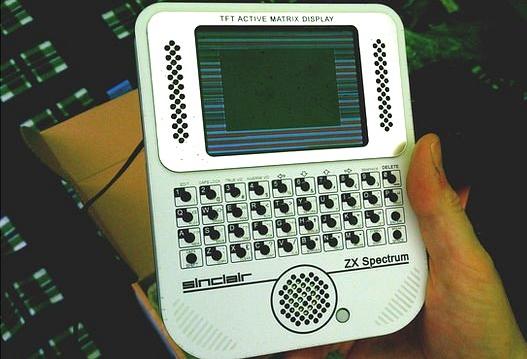
|
101010101
Reduced Rates for CCS Members: IEEE Annals of the History of ComputingIEEE Annals of the History of Computing is the pre-eminent archival journal for the history of computing. Launched in 1979 it is a peer-reviewed quarterly publication featuring articles by computer experts, historians, and practitioners, and includes unique first-hand accounts by computer pioneers. By arrangement with the publishers, members of the CCS are able to benefit by reduced rate subscription to the Annals. If you are interested taking advantage of this arrangement for either the print edition or the digital edition please let me know. The first issue for new subscribers will be available January 2015 though to secure an advantageous rate we need to know the number of likely subscribers now. Please register your interest by emailing me at: doron.swade@blueyonder.co.uk. Expressing interest at this stage does not entail a commitment to subscribe. Registering an interest now simply allows me to send you further details when the rates are known. Doron Swade |
In this short article I will try to provide a potted history of Ferranti electronics development in Canada, and the interactions leading up to the adoption of the FP6000 as the basis of the ICT 1900 range. I will also throw in a couple of personal reminiscences. I will be mentioning some names that may have no meaning for most of you, but should ring bells for some.

|
| DATAR |
The history of the organisation that became Ferranti-Packard is one of a number of leading-edge, sometimes brilliant, developments which failed to become great commercial successes. Ferranti UK originally established Ferranti Electric as a Canadian subsidiary to advance its mainline business of transformers and the like. In 1949 an Electronic Research Group was set up in the Canadian subsidiary company to meet the requirements of what was essentially a skunkworks project from within the Canadian Navy. This was DATAR (Digital Automated Tracking and Resolution), a project way ahead of its time. It was intended to allow fleet and shore stations to gather and share radar and sonar data. It was on this project that Fred Longstaff, the future architect and chief designer of the FP6000, cut his teeth.
In 1953 a demonstration of the prototype system was mounted on Lake Ontario, with equipment installed on two minesweepers and in a shore station. That this was successful was something of a miracle when one recalls the size and reliability of the valve technology available at that time.
In spite of this success and the acclaim of the RCN, DATAR did not proceed further because of a mixture of development delays, US NIH syndrome, a UK competitor (CDS) and, most importantly, Canadian government finance concerns.
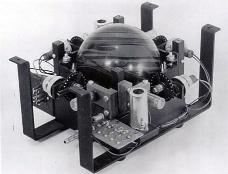
|
| The First Trackball |
It did however have one lasting global outcome – the invention of the tracker ball by Fred Longstaff and Tom Cranston on their way to a meeting. Although later ubiquitous in its upside down form as a mouse, the idea was never patented, because it formed part of a secret project.
In 1953, the Department obtained a contract to produce a prototype mail sorter, which it did successfully using the valve technology of DATAR. But by the time this was complete transistors had arrived on the scene. In 1956 Ferranti Canada received $1 million for a follow-up project to develop a transistorised sorter for use in the Ottawa post office. This was the first such operational system in the world – the US, who sent a Congressional mission to check it out – did not have such a system until 1960, and the UK had to wait until 1966. This should have been a golden opportunity for Ferranti to supply all the major Canadian post offices, but unfortunately politics raised its ugly head. A new Conservative government was determined to cancel all the previous administration’s “waste”, and no further orders were placed.
In 1956, Ferranti was also involved in JANET, a system of communication by bouncing radio waves off the ionised trails left by meteors. Again amazingly, at least to me, this was successful. It was made obsolete by the arrival of satellites, although it was resuscitated by another company much later
In 1958, Ferranti bought up Packard Electric, a competitor in the heavy electrical market, and the two companies were merged to form Ferranti-Packard. While most of the senior management posts were taken by Packard staff, a separate Electronics Division was established with its own general manager. Since the majority of the company management had little knowledge of electronics, this became a largely independent entity.
The final electronic development before moving towards programmable computers, and Ferranti Canada’s first major commercial sale, was to provide a cheque sorting system for New York City’s Federal Reserve Bank. Ferranti-Packard gained the contract because the customer had heard of the mail-sorting system and realised that it was similar to their application. This again was a successful development with, at its heart, a hard-wired computer. However, by the time it was complete, companies like Honeywell were investigating the use of general-purpose, programmable computers which were much more flexible, so again there was no follow-on business.

|
| A RESERVEC Transactor |
The chance for a first step towards general-purpose computers came from Trans Canada Airways (now Air Canada). They had realised the need to automate seat reservations as early as 1953, when senior management had been given a demonstration of a computer’s capabilities on the University of Toronto’s Ferranti Mk1. Ferranti Electric then developed a suitable input/output box called a “transactor” in 1956. Six of these were connected to the Mk1 for a more realistic demonstration, which resulted in 1959 in a contract to build the entire system – central computer, hundreds of transactors and communications interfaces.
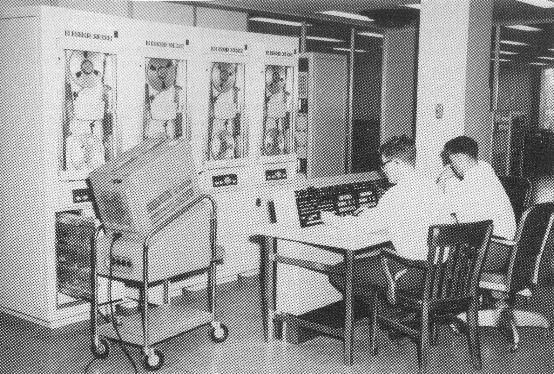
|
| At Last a Proper Computer:RESERVEC |
Called RESERVEC, its heart was a twin computer system named Gemini, which provided mutual backup but also allowed the workload to be shared. It used the transistor circuit techniques developed by Ferranti at Wythenshawe – the real-time computer department which had produced the Argus computer. Each computer consisted of a small number of plug-in printed-circuit cards, which could be used in other projects. The overall designer was Fred Longstaff, who was both a hardware and software expert. While very successful, the FP curse struck again, and in spite of a world-wide sales effort aimed at airlines and railways, no further systems were sold.
The basic logic cards were then reused in a secret project for the Canadian government involving cryptography.
While neither Ferranti-Packard management nor the parent company were keen for FP to move into general-purpose computers, the next step in the process came courtesy of the New York Federal Reserve. Based on the success of the cheque sorting system, a systems engineer called Paul Dixon was able to persuade the bank that their next step should be a general-purpose computer. This contract led to the development of the FP6000, which was built using RESERVEC technology. The same technology was also being used in the UK for the Orion II project. Ferranti UK gave the go-ahead and said that if it worked they would offer it for sale in the UK. The Federal Reserve system was installed and running in March 1963.
FP6000, regarded as a sort of Pegasus replacement, re-used several of the ideas that had been developed in the Ferranti range in the UK: a simple operating system, called EXECUTIVE; multi-programming of up to four user programs, protected by datum and limit registers; and extracodes. Fred Longstaff was the chief architect/designer. A typical add time was 7 microseconds. Input from slow peripherals was on a hesitation basis – computation could continue between the individual transfers, but a program could ask to be suspended until the transfer was complete, allowing other programs to use the CPU. The one architecture feature that caused the most difficulty for the UK was the choice of a 24-bit word and 6-bit characters. This limited the address field in a non-branch instruction to 12 bits, 15 bits in branch instructions. Software for the FP6000, apart from EXECUTIVE, included an assembler, called Autocoder, a FORTRAN compiler, and an Algol 60 compiler. Not all of these were available for the first deliveries.
The first visit to Toronto by a fact-finding team from Ferranti UK took place in that same month and was described in Hugh Devonald’s 1996 talk which is reported in Resurrection 16. It concluded that, although FP6000 had some facets that were not liked, it would take UK at least 18 months to produce something in the same price/performance range.
The report had very quick results. Although the ICT takeover of Ferranti Computers was publicly only rumour, a top level ICT/Ferranti party went to Toronto in April 1963, made up of Arthur Humphries, “Echo” Organ, Tom Shepherd, Peter Hall and Hugh Devonald. The ICT members were impressed with what they saw.
The third visit is where I play a small part in the picture. I had joined Ferranti in 1962 to work on Atlas, and in June I963 was asked by John Davison to accompany him to Toronto. Hugh Devonald was already there and we were joined later by Bruce Patterson. But we were also joined by a number of people, who were not of Ferranti, some of whom introduced themselves as ex-EMI. As a lowly employee, this was the first proof I had that the takeover rumour was true. The full party included, if my memory serves me, Dennis Pearson, Brian Millis and Tony Hetherington, although other people came and went.
My tasks were to learn the FP6000 order code, to find out as much as I could about the software and to collect as much documentation as I could carry. My main contact on the hardware side was Fred Longstaff and for software Ian Sharp, but I met with several other members of the team. My impression was of a very bright and closely-knit group. On my return to the UK, I got the job of developing and giving an internal FP6000 programming course, which, after the merger became official, continued in ICT, and included training ICT training staff.
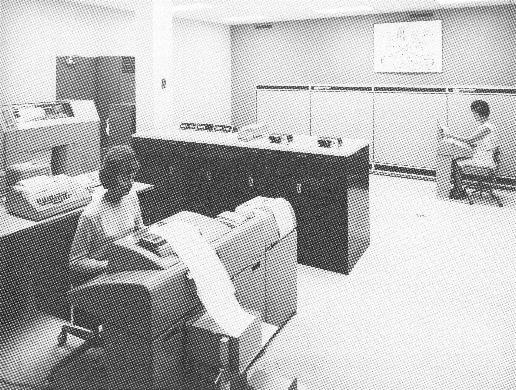
|
| FP6000 at the Toronto Stock Exchange |
In spite of limited marketing and sales strength, Ferranti-Packard managed to sell another four FP6000s; to the Toronto Stock Exchange, Saskatchewan Power Corporation, The Defence Research Establishment at Dartford, Nova Scotia, and Ferranti UK in Edinburgh.
After the merger the sales and support staff from Ferranti were placed in a sales division under Chris Wilson (who later became ICL’s MD). They continued to market the FP6000, even as the 1900 range was being developed. Alan Thomson has unearthed four sales reports to different organisations, dating from November 1963 through to January 1964.
To end on a sad note, ICT saw no future for Ferranti-Packard as part of the company. They were given $1M in compensation but were essentially left without a product. The team broke up. Fred Longstaff and several hardware engineers founded ESE, which was later bought by Motorola. Several of the Ferranti-Packard staff went on to become senior Motorola managers. Ian Sharp, with some of the software team, established I P Sharp Associates, which became one of the largest software houses in Canada and was bought by Reuters.
But the 1900 went from strength to strength!
This article is based on notes for a talk given at the London CCS meeting on September 11th on the occasion of the 50th anniversary of the launch of the ICT 1900 Series. The author can be contacted at jkb@bcs.org.uk.
In the late 1940s, at the Division of Radiophysics of the Australian Council for Scientific and Industrial Research (CSIR), a team led by British emigrant physicist Trevor Pearcey and Australian electronic engineer Maston Beard designed and built one of the world’s first stored-program electronic computers. The CSIR Mark 1 executed its first test program in late 1949.
The machine was exhibited to Douglas Hartree and others at a computer conference in Sydney in August 1951. By then it was in use for scientific computations and had already been programmed to produce the some of the earliest computer generated music.
In 1955 the computer was moved to the University of Melbourne where (renamed CSIRAC) it provided a computing service until 1964.
The entire machine, including its original design documents and circuits, software library and custom-built peripherals, has been preserved intact. Since 2000 CSIRAC has been on permanent display at the Melbourne Museum.
Trevor Pearcey worked on radar development in Hampshire and at Great Malvern, including working with Douglas Hartree and Leslie Comrie. He came to Australia in late 1945 to work on long distance microwave propagation at the Division of Radiophysics of the Council for Scientific and Industrial Research (CSIR). Radiophysics was located within the grounds of Sydney University. During WWII it had established a strong reputation in radar research and development and post-war became a leader in radioastronomy and aircraft landing systems such as DME and Interscan.
Pearcey recognised the need for greatly improved computational facilities in all aspects of the research work at Radiophysics. He was not aware of the Robinson and Colossus achievements at Bletchley Park, but en route to Australia he had visited Howard Aitken and the ASCC although he did not see ENIAC or the Bell relay machine.
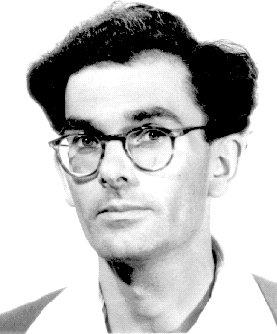
|
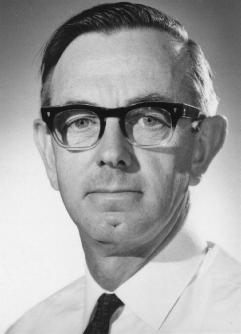
|
| Trevor Pearcey and Maston Beard | |
Pearcey developed preliminary ideas for computing equipment in 1946 and by 1947 had joined forces with electronic engineer Maston Beard. Maston Beard had gained experience in radar development during the war and was applying his knowledge of pulse techniques to aircraft navigational aids. Together Beard and Pearcey tackled the task of developing practical electronic systems for computation. One of their projects was the logical design and physical construction of a stored program computer – the CSIR Mark 1.
The computer had a word length of 20 bits and provision for 1024 memory locations. Instructions comprised a 5-bit “source” field and a 5-bit “destination” field with 10 bits for the memory address. This provided a useable repertoire of about 250 valid instructions. Data could be 20-bit integers or signed 19-bit fractions. Integer multiplication was implemented in hardware.
There were 20 arithmetic registers:
| A | (20-bit general purpose accumulator), | |
| B | (20-bit multiplier register), | |
| C | (20-bit multiplicand and accumulator register), | |
| H | (10-bit half register) and | |
| 16 D | (index) registers each of 20 bits. |
Provision was made for arithmetic operations to be performed on both the S (sequence register) and K (instruction register). Among other advantages this enabled relative addressing to facilitate relocation of routines. One useful feature was the queue that held the 16 most recently executed instructions. The logical design was essentially completed in 1947.
On hearing of the successful projects at Manchester, EDSAC and the Pilot ACE, Pearcey visited the UK in late 1948. He later stated: “The EDSAC and MADAM had been performing simple programs since the middle of that year. During this visit the basic logical design of the CSIRAC was confirmed and was not thereafter significantly changed. The main advantage gained from the visit was the detailed electronic design of some functional elements, such as arithmetic circuits and the more complex gates.”
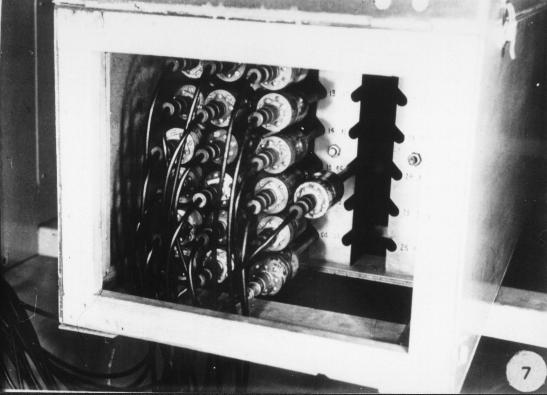
|
| End View of the Mercury Delay Line Stores |
The CSIR Mark 1 was implemented using about 2000 vacuum tubes.
It was a serial machine with a master clock speed of one Mhz. The memory employed mercury delay lines – a legacy of radar technology. In practice only 768 of the possible 1024 memory locations were implemented. The circulating time was 960 microseconds. This provided an execution rate of the order of 500 per second. The registers were also implemented using short delay lines for the 20-bit A, B and C registers and the 10-bit H register and a full length delay line for the 16 20-bit D (or index) registers. The design objective was, of course, to minimise the number of thermionic valves (vacuum tubes) in the interest of cost and reliability.
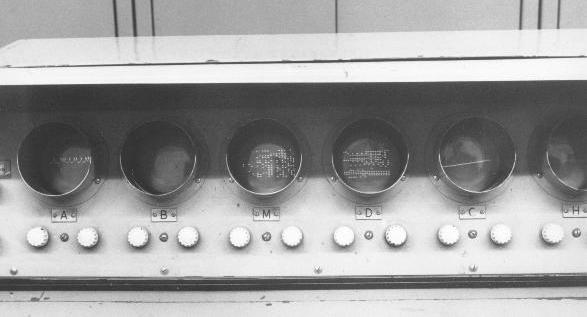
|
| The CRT Screens |
The user was provided with a complete set of CRT screens. These enabled the examination of all memory locations, the arithmetic registers and the list of the 16 most recently executed instructions. The latter facility, along with the “trigger stop” which enabled execution to be paused at a pre-determined instruction and a single-step capability, was an aid to debugging. Neon lights displayed the bit pattern in the sequence and instruction registers.
One of the destinations specified in the instruction set was a loudspeaker. This was designed as a “hooter” with the capability of generating different sounds by varying the pulse stream sent to the analogue audio stage.
The total power consumption was about 35 kilowatts. There was no air-conditioning but forced air fans dissipated the heat. Because the transit time in the mercury delay lines was temperature dependant, variations in temperature were combated by having a dummy delay line located with the memory lines. This line controlled a feedback loop which varied the master clock speed to compensate for variations in the circulating time of the memory delay lines. (Later in Melbourne, as a further aid to stability of operation, the box containing the mercury delay lines was provided with a thermostat and a heater that maintained the lines at a constant temperature – set above the usual ambient. This worked satisfactorily except on the hottest summer days when ambient temperatures in the room exceeded 40° Celsius).
By late 1949 the computer was sufficiently complete to run its first test program. When it was publically demonstrated at the first Australian Computer Conference (attended by Douglas Hartree) in 1951 the computer was already in use for scientific calculations and was playing computer-generated music.
In the early 1950s, engineer Brian Cooper constructed various magnetic backing stores for the CSIR Mark 1. Initially these were of a cylindrical “drum” configuration with words read in parallel from a line of heads. One version had a mean access time of 5 milliseconds. The final configuration, which was used throughout its working life in Melbourne, was a single platter disc store with fixed head parallel read/write. The single surface provided a capacity of 1024 20-bit words.
During the life of the computer the performance was enhanced by techniques recognisable to later computer designers. In Sydney Reg Ryan, the engineer responsible for the design of the memory system, doubled the capacity of each delay line by interleaving the acoustic pulse streams. Before the computer left Sydney Maston Beard improved the reliability of the control unit. Later in Melbourne the senior maintenance engineer Ron Bowles devised and implemented modifications which optimised the timing of the processor’s execute cycles and thus reduce the execution time of programs.
The character set adopted was 5-bit Baudot code. The console printer was a modified post office teletype. Initially Hollerith punch card equipment was used for input and output of programs and data. However, this proved unreliable and was soon abandoned and a unique 12-channel paper tape system was developed to replace it. This was rather like a 12-row card of indefinite length. The 12-channel tape readers and tape punches were all custom built at the Division of Radiophysics.
In 1952 CSIRO (By this time the title of the CSIR had been changed to Commonwealth Scientific and Industrial Research Organisation) sought expressions of interest from local electronic companies for the development and marketing of commercial versions of the CSIR Mark 1 but the tenders received showed the proposal to be uneconomic.
By 1954 it was clear that the CSIR Mark 1 would be superseded in Sydney by the proposed new computer SILLIAC (a copy of the ILLIAC) that, as a result of the drive of Physics Professor Harry Messel and the philanthropy of Adolph Basser, was to be constructed by Sydney University. A new home was sought for Pearcey and Beard’s machine.
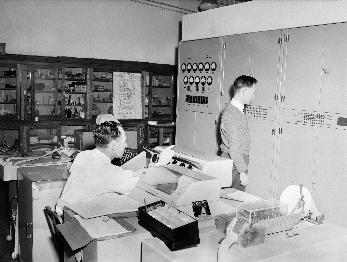
|
| CSIRAC after Relocation to Melbourne |
Ultimately Sir Thomas Cherry FRS, the redoubtable Professor of Mathematics at the University of Melbourne, arranged to have the machine transferred to the University. So in 1955 the only operational computer in Australia was dismantled and loaded onto a semitrailer and trucked 500 miles south to Melbourne.
At the University of Melbourne a Computation Laboratory was established in the Physics Building. The computer was reassembled and set up as a teaching and computing facility (the first computer bureau in Australia) primarily for University and CSIRO staff but also for commercial customers. Courses in programming were developed and presented and the computer was officially re-launched as CSIRAC (Commonwealth Scientific and Industrial Research Automatic Computer) on 14th June 1956.
The Computation Laboratory and its staff were instrumental in introducing computers to university students and staff and CSIRO scientists and through public events and open days, to the wider community.
The Computation Laboratory was conducted on an “open-shop” basis. Users booked time slots and operated the computer themselves, often in all night sessions. Hundreds of projects were completed over the following nine years in areas as diverse as nuclear physics, meteorology (including some of the very earliest numerical weather forecasting), banking, structural analysis, solar radiation, power utility grid calculations and computer games. The computer was also used to assist in the design of another notable Australian computer – the Cirrus. Just as importantly, the computer provided the first programming experience for hundreds of students and staff.
The usability of the computer was greatly improved by the development in the late 1950s of an interpretive language “Interprogram” by Geoffrey Hill. Interprogram was comparable in ease of use to the later BASIC language. This enabled a wider range of people to program and use CSIRAC. The development and implementation of such a facility on a machine of less than one kilowords was a tour de force. Geoff Hill (who also created the first computer generated music in Sydney in 1950/51) is considered to have been Australia’s first super programmer.
The reliability of the computer improved over time. However, one hazard both to the Computation Laboratory personnel and the program reliability was the proximity of high-energy physics accelerators. One of these, a 600KV Van der Graff generator, could introduce spurious bits in the CSIRAC memory when it discharged to ground. The other, a cyclotron, would cause the computer to lose bits due to power brown-outs when the motor generator that powered the cyclotron beam magnet was started. Regrettably these two influences did not cancel each other out.
Later, Ferranti and Creed 5-channel paper tape peripherals were added. These enabled Friden Flexowriters to be used for off-line preparation of data and for off-line printing. They also allowed research data collected by means of data loggers to be input. It then became usual practice to use 12-channel paper tape for programs and 5-channel tape for data. However, 5-channel tape was used for Interprogram program input.
Towards the end of the computer’s working life, engineer Jurij Semkiw built circuitry which enabled the second side of the disc to be used, thus doubling the capacity to 2048 words. The read circuitry for this late upgrade was implemented using germanium transistors. Due to difficulty in sourcing power transistors the write circuitry was still based on vacuum tubes.
In November 1964, almost nine years after its relocation and 15 years after executing its first test program, the machine was turned off for the last time. By then it was recognised that the CSIR Mark 1/CSIRAC was an important artefact – the oldest working computer anywhere. It was dismantled and transferred to the Victorian Applied Science Museum where it languished in storage for 16 years.
In 1980 the IFIP 80 Congress was held in Melbourne. By then Trevor Pearcey was Dean of Computing and Information Systems at Chisholm Institute of Technology (now part of Monash University). He arranged for the computer to be taken from storage and displayed at the Institute during and after the conference. It was later returned to a museum store.
In 1996 the Computer Science Department at the University of Melbourne launched a project to document the history of the computer and ensure its preservation and public display. CSIRAC was again removed from the museum store and set up at the University of Melbourne under the supervision of the engineers Ron Bowles and Jurij Semkiw who had conducted the original installation at the university 40 years earlier.
The reassembled machine formed the centre piece of a conference held in June 1996 – the 40th anniversary of its official reopening in Melbourne. Surviving pioneers were invited to participate. Following the conference, work commenced on collating all the available material regarding the history of the machine. This culminated in the publication of a book: The Last of the First – CSIRAC: Australia’s first computer. Meanwhile, Museum Victoria commenced the task of preparing the computer and associated material for permanent exhibition in the newly completed Melbourne Museum.
The CSIRAC exhibition at Museum Victoria is a static one as the computer is not operational. We have frequently been asked why we have not attempted to return it to an operational state. The thinking is as follows: the computer is intact and original. In order to attempt to restore it to operation it would be necessary to replace many components particularly capacitors, probably resistors and much of the wiring. In doing this we would destroy the originality of the machine. Furthermore, in its heyday the machine required careful tending by engineers who spent their working life with it. Once that expertise is no longer available we would have again a non-functioning but now non-original machine.

|
| CSIRAC in the Museum Victoria |
Further obstacles to re-commissioning are occupational health and the safety issues relating to mercury exposure and the fire hazards inherent in aged power supplies handling 35 KW.
CCS Web Site InformationThe Society has its own Web site, which is located at www.computerconservationsociety.org. It contains news items, details of forthcoming events, and also electronic copies of all past issues of Resurrection, in both HTML and PDF formats, which can be downloaded for printing. We also have an FTP site at www.cs.man.ac.uk/CCS/Archive, where there is other material for downloading including simulators for historic machines. Please note that the latter URL is case-sensitive. |
Trevor Pearcey died in November 1998. His obituary came to the attention of Paul Doornbusch, an Australian expatriate computer scientist and composer, who was at that time a professor of composition at the Conservatorium at The Hague. Paul suggested that it might be possible to re-create the music played by CSIRAC. With assistance from the Australian Council for the Arts, we arranged for Paul to return to Australia and lead this project. The effort involved in the project was substantial and included:
| – | development of a complete emulator of the CSIRAC by John Spencer, |
| – | reconstruction of the original music programs by Ron Bowles and John Spencer which involved reading many metres of paper tape by eye, |
| – | construction of a paper tape reader to read 12-channel paper tape, |
| – | design and construction by Jurij Semkiw of equipment which precisely replicated the timing pulses generated by the clock system of CSIRAC. |
| – | construction by John Spencer of a replica of the final analogue output stage of the CSIRAC “hooter:” circuit. |
The results of this work have been published and Dr Doornbusch has produced a book The Music of CSIRAC. Samples of the CSIRAC music may be found at www.doornbusch.net/CSIRAC/. [Ed] recommends Colonel Bogey.
The execution by the CSIR Mark 1 of the first test program in November 1949 is accepted as marking the birth of the digital age in Australia. Major commemorative events were held in November 1999 for CSIRACs 50th birthday and again for the 60th anniversary in 2009. The computer has been granted the Engineers Australia Landmark award and is listed on the Heritage Register for the State of Victoria – one of the first objects to achieve this recognition.
On the death of Dr Trevor Pearcey, senior members of the Australian computer industry established the Pearcey Foundation. The Foundation confers the pre-eminent national awards for achievement in the ICT field. The most prestigious of these is the Pearcey Medal.
Peter Thorne worked with CSIRAC as an undergraduate. In 1996, whilst Head of Computer Science at the University of Melbourne, he initiated the project to document CSIRAC and reassemble it for public display. He can be contacted at pgt@livenet.com.au.
Dr Trevor Pearcey (1919-1998) had a prime role in the development of computing in Australia with his involvement in both research and academic activities. Dr Pearcey moved to Australia in 1946 to take up a research position with CSIR, the Council for Scientific and Industrial Research, the primary Australian government research organisation. This was the beginning of a varied career in both government and academic institutions with many achievements, including the project proposal and then completion of the logic design for CSIR Mark 1 (later renamed CSIRAC), the fourth first-generation computer in the world. Dr Pearcey maintained an academic role throughout his career and had a long involvement with Monash University’s Caulfield campus.

|
| Trevor Pearcey c. 1940 |
Trevor Pearcey was born in Woolwich, England in 1919 and attended the Imperial College of Science and Technology, London from 1938. He graduated in 1940 with an Associateship of the Royal College of Science (ARCS) and B.Sc. (Special) degree of the University of London, 1st Class Honours in Physics. With Britain’s wartime commitments, Pearcey did not continue studies for a doctorate but began work for the Ministry of Supply and was posted to ADRDE (Air Defence Research and Development Establishment), Great Malvern. This was a research facility primarily involved with army radar development. From 1940-1945, Pearcey undertook research in ‘the theory of microwave physical optics, antenna design, scattering functions and propagation beyond the horizon in inhomogeneous stratified atmospheres.’ The work required large numbers of calculations and this brought him into contact with Professor Douglas Hartree and his team at Manchester University using the Differential Analyser as well as the similar machine at Cambridge University. He also worked with L.J. Comrie, then Director of the Scientific Computing Service in Bedford Square, London. These facilities introduced Pearcey to the concepts of computation using both the differential analyser as well as punch card systems. Pearcey produced a large number of reports throughout this period including one with Professor Hartree and his team.
In 1945 the war research effort was being wound down and Pearcey answered an advertisement for a position as a research physicist in the Division of Radio-Physics, CSIR located on site at Sydney University. Pearcey arrived in Australia in early 1946 and took up his position to pursue studies on long-distance microwave propagation. CSIR had recently appointed Dr. E. Bowen, a major contributor in the development of radar technology, to the position of Deputy Chief of the Division. Pearcey was in communication with Bowen in mid to late 1945 prior to his arrival in Australia. Pearcey travelled to Australia via the US in late 1945 to study propagation; he used this journey to visit Howard Aiken at the Cruft Laboratory to see the Automatic Sequence Controlled Calculator (ASCC) as well the relays for the Harvard Mark II being tested. He also met Wendel Furry who was using the ASCC for calculations for radar and sonar wave-propagation theory.
However it soon became obvious that again large numbers of calculations were required for his research and Pearcey started to work on his preliminary ideas for a computer; developing a list of principles required in a computer in 1946. He combined his efforts as logic designer with Maston Beard, an engineer also working on radar research at the Division of Radio-Physics, who started to devise the hardware required for the project. Their proposal to build a computer was accepted by CSIR and in 1947 they commenced their work to build a computer under the title of the CSIR Mark 1. The CSIR also created a new Section of Mathematical Instruments under D.M. Myers in 1948 to provide computing services including special computing facilities. The first successful test program was run on CSIR Mark 1 in November 1949. It was the fourth first-generation stored program electronic computer in operation in the world. It was a notable achievement as the Australian-based designers had little or no knowledge of the current British or US research in computing. Although Pearcey knew of the differential analyser, he had no prior knowledge of the secret work carried out at Bletchley Park or the American research on ENIAC at the Moore School. He first heard of ENIAC in 1947. Pearcey did have discussions with Professor Hartree in early 1945 about the possibilities of using electronics for fast computation. Along with his knowledge of ASCC, Pearcey also cited an article by Walter Pitts and Warren McCulloch published in 1943 that discussed logic but not computer programming as a resource for his work on logic development.
During this period, Pearcey also used his wartime experiences with punch card technology to modify a number of British Tabulating Machine punch card machines for scientific mathematical requirements. At the inaugural Australian computing conference, Conference on Automatic Computing Machines, held in Sydney in 1951, both the CSIR Mark 1 and the punch card machines were demonstrated to the audience. Professor Hartree was a guest speaker at the conference. In 1949 CSIR was officially re-named CSIRO, the Commonwealth Scientific and Industrial Research Organisation.
While working for the CSIRO, Pearcey also started teaching undergraduate students from 1947 until 1952 in the Department of Mathematics, Sydney University under Professor T.G. Room. The course was an introduction to the theory of computation, computing practices and the principles of programming. These were the first university classes in computing presented in Australia.
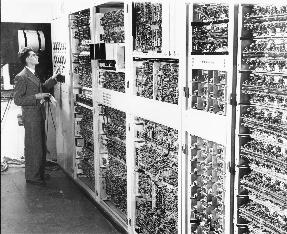
|
| Trevor Pearcey with CSIRAC in 1952 |
Meanwhile work continued on developing the CSIR Mark 1 with papers produced during the 1950s on both aspects of the programming and hardware. Pearcey was responsible for development of its programming methods and assisting research workers at the CSIRO and outside users to apply the computer in their work. He also used the computer for his own problems including aspects on the nature of motion in bodies in viscous media and droplet dynamics which was part of a major focus of CSIRO research at the time in the studies of ‘rain-making’. The computer was decommissioned by the CSIRO in 1955 and transferred to the University of Melbourne with the new designation of CSIRAC. It was in operation until late 1964 when it was turned off and, along with a range of paper tape programs, documentary material and photographs donated to Museum Victoria for preservation. The computer is currently part of the public display at Melbourne Museum.
In 1957 Pearcey took a leave of absence from the CSIRO and returned to the UK to work as a Principal Scientific Officer at the Royal Radar Establishment (RRE) at Great Malvern for two years. He was involved with the development of compiler techniques which were applied to RRE’s own computer built in mid-1953 known as TREAC (Telecommunications Research Establishment Automatic Computer) as well as working with the team designing a new computer, with the acronym RREA, for RRE.
Pearcey returned to his work with the CSIRO in Australia in 1959 and transferred to the Division of Mathematical Statistics to participate in planning for a computing laboratory for CSIRO. He was located at the Computation Laboratory, University of Melbourne which also housed CSIRAC at this date. Pearcey was seconded to the Department of Mathematics, University of Melbourne to teach third year students a full-year course in numerical methods and computing systems with practical work on CSIRAC.
In the early part of the 1960s Pearcey, working with Dr Geoff Hill (who was also involved with CSIRAC at the University of Melbourne) undertook a survey of existing and potential needs for computing research and devices across CSIRO and some government departments. In view of the wide geographical distribution of the various divisions, Pearcey proposed that there should be a network of computing facilities of various levels of computing capabilities. If a local facility could not process a job, then the program and data would be sent to a higher-level facility on magnetic tape; once processed, the result could be sent back to the local facility on tape and printed out. This proposal was accepted by the CSIRO in 1962 and the Commonwealth Government provided a grant of A£3,000,000 to establish a Section of Computing Research within the CSIRO. Pearcey moved to Canberra to be located at the CSIRO’s new Section of Computing Research in 1964. The CSIRO network was established and based around a CDC3600 computer in Canberra and three CDC3200 computers located at sites in Sydney, Melbourne and Adelaide. This set of computers operated either individually or, if required, communicating across the network by using magnetic tape transfers with a 24 hour turn-around time between the central system and the lower level systems. The network was upgraded from the physical transmission of data to electrical transmission in stages from 1966. Eventually it was developed into a large, multi-node, multi-level network called CSIRONET.
Apart from his work with CSIRO, Pearcey also participated in a project led by Professor M.S. Allen to design and build a computer at the University of Adelaide. The computer, named CIRRUS, was developed from 1959 to 1962. It was entirely developed in Australia and was placed in operation in 1963. It was the first multi-program, multi-terminal system in Australia.
There was increasing interest in forming state-based computer societies during the early 1960s in Australia. Trevor Pearcey was an active member of the computing community. The Victorian Computer Society was formed in 1961 and he became the Vice-President from 1961-1965. On his transfer to Canberra, Pearcey joined the Canberra Computer Society and was President in 1965. These different groups were amalgamated into the Australian Computer Society in 1966 and Pearcey was Vice-President from 1966-1967 and then President for 1967-1968. Pearcey was made a Fellow of the British Computer Society in 1968 and a Fellow of the Australian Computer Society in 1969.
At this stage, Pearcey took another leave of absence from CSIRO and joined Control Data Corporation in August 1968 at their laboratory in Minneapolis, USA. He worked on the CDC STAR 100 system. Pearcey returned to Australia and worked at the CSIRO from 1970 to 1971 on the effect of damping on sub harmonic motion. He then joined the Melbourne office of Control Data Australia working on data base systems for the Australian environment. He was also at this time, a Visiting Fellow in the Department of Information Science, University of Melbourne.
Trevor Pearcey was awarded a Doctor of Science for research in information science by the University of Melbourne in 1972. In support of his doctorate, he presented three volumes of his published research from the 1940s until 1971.
Now Pearcey moved into a permanent academic position in 1972 with his appointment as Head of Department of Electronic Data Processing, Caulfield Institute of Technology. The Institute had been teaching EDP and computing courses since the early 1960s and Pearcey was able to develop the department, especially in the area of commercial data processing. After internal changes at Caulfield Institute of Technology, Pearcey was named Dean, School of Computing and Information Systems in 1979. He then initiated developments in digital communications, robotics and digital technology. After the formation of the Chisholm Institute of Technology, which merged the Caulfield Institute of Technology and the State College of Victoria, Frankston in 1982, Pearcey was appointed the Foundation Dean of the new Faculty of Technology (combining Applied Science, Engineering and Computing and Information Systems) and held this position during 1984 until his retirement at the end of that year. Upon his retirement, Pearcey was made the first Fellow of Chisholm. The following year he was commissioned as a consultant by Chisholm Institute of Technology to develop an overall plan for the information technology requirements for the institute. This plan was submitted in March 1986 and covered both the administrative, academic and technical requirements for all computing uses on the different campus locations. He continued his association with the computing school and was involved with researching Non-Linear Dynamics in the late 1980s. The Chisholm Institute of Technology was merged with Monash University in 1990.
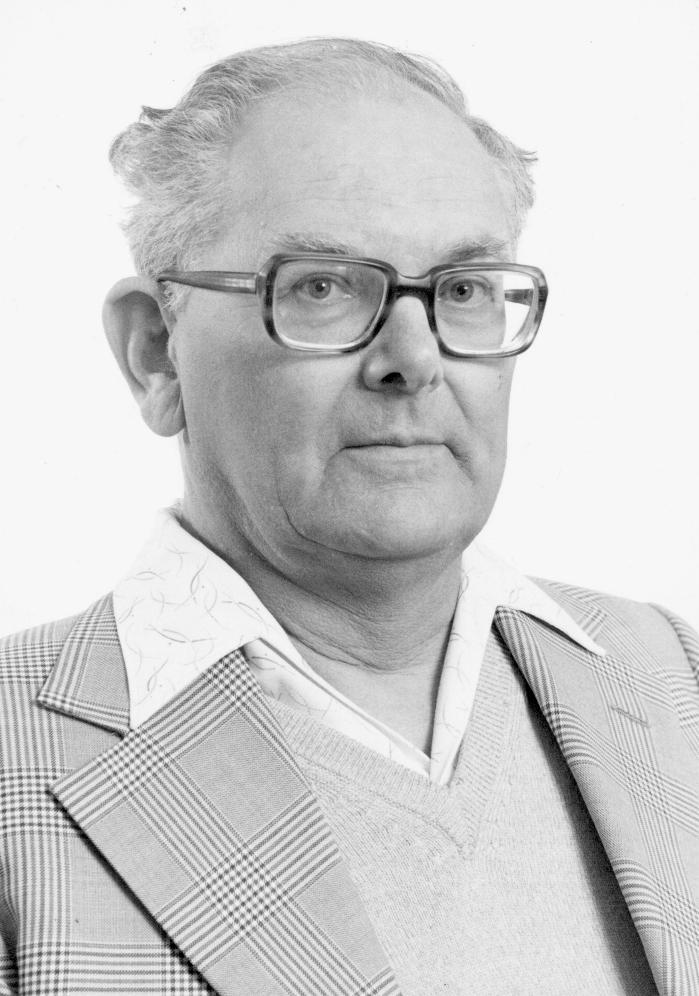
|
|
Trevor Pearcey in 1984 (Courtesy Monash University Archives) |
Dr Pearcey undertook a major project in the mid-1980s to record the history of Australian computing activities. He felt that there were few resources on the history of computing in Australia and that generally there was little acknowledgement of the value of local developments. He commenced to interview many of the early participants and look through the vast number of research reports in government, university and CSIRO archives. Pearcey was impressed by the level of Australian research but frustrated by the constant lack of development of local opportunities and neglect of Australian expertise. Published in a limited edition in 1988, his work A History of Australian Computing remains a significant resource for computing history research.
A number of projects and schools were named in honour of Dr Pearcey. The Chisholm Institute of Technology commenced the Pearcey Centre for Computing in 1976. This was a specialised school for computer education and provided classes at both the Caulfield and Frankston schools. In 1987 a new computer centre building in the Fern Hill Technology Park, Canberra was officially named Trevor Pearcey House.
After his death in 1998, the Pearcey Foundation (www.pearcey.org.au/Welcome) was established in memory of Dr Pearcey. The Foundation has a number of functions including the recognition of outstanding ICT achievements across Australian through an annual award program as well as maintaining a public profile in the ICT industry.
Dr Trevor Pearcey died in January 1998. He had entered the field of computing at an exciting time. His wartime work on radar research introduced him to some of the key figures in analogue computing development in the 1940s; in particular, his meetings with Professor Hartree and the team at Manchester University had a major influence on his interest in computer research. The move to Australia put Pearcey in the position to work with similar-minded people at the CSIRO on the use of electronics in fast computations. The CSIRO later stopped their development program in computing after 1954 but the successful completion of the computer CSIR Mark 1 (later called CSIRAC) was a notable world achievement in computing. While developing his technical knowledge through research in Australia and England as well as in the private sector, Pearcey also continually supported computer education from his first lectures in the late 1940s to his work at the Caulfield Institute of Technology.
Barbara Ainsworth is Curator, Monash Museum of Computing History. She can be contacted at barbara.ainsworth@monash.edu.
North West Group contact details
Chairman Tom Hinchliffe: Tel: 01663 765040.
|
Users line-up for ICL’s New Range: Universities, commercial and Government installations expressing strong interest in the 2970 and 2980, both due for launch in October. (CW 409 p1)
Farnborough: As the first International air show at Farnborough opened, GEC-Marconi Electronics’ avionics systems subsidiary, Marconi-Elliott, is expecting to get £5m of business for its GEC 920M based Navwas digital navigation and attack system out orders placed for the Anglo-French Jaguar which was announced last week. (CW 409 p1)
Myriad for Midlands Network as the first phase of a supervisory and control system for the operation of the Midlands Electricity Board’s Birmingham area distribution network has been established, based on a 16K Marconi Myriad. (CW 409 p21)
Rank Xerox 530 for Stevenage-based Water Research Centre to replace a leased terminal system. The Centre is also uses Texas Instruments kit in a new telemetry system. (CW 410 p11)
Terminal gives new hope to blind: Monash University in Melbourne has developed a general purpose Braille remote computer terminal which prints Braille. (CW 410 Int. Ed. p1)
Double move to block Fednet plan: Following the Congressional veto of funds, and the subsequent shelving of plans, for the US General Services Administration’s Fednet data communications network, the US Senate has now approved moves to prevent the GSA continuing to work on the project. (CW 410 Int. Ed. p7)
Rolls Royce to use NAG library: Following moves to widen the distribution of the NAG library to commercial interests, Rolls Royce is said to be considering a purchase. (CW 410 p40)
IBM introduces telecoms package: In a move to further improve its position as a supplier of data communications equipment, IBM has introduced an all-embracing teleprocessing system utilising its SDLC transmission line protocol. (CW 412 p1)
Stand-alone system for air travel: Having secured a major share of the online air terminal business, Raytheon Data Systems has introduced a stand-alone passenger servicing system, the Raytheon Information Management System, for use at airports. (CW 412 p3)
TV data service nearer: An up-to-the-minute news and information service, based on the Oracle data transmission system using modified domestic TV receivers, is planned by the IBA and the Home Secretary has approved the introduction of both Oracle and the BBC’s Ceefax system for a two year experimental period. (CW 412 p6)
Online system for daily paper: An online system for Birmingham Post and Mail is to be supplied by ICL, in direct competition with IBM. The £0.5m contract is, initially, for two 44k 1901Ts to be implemented in two stages, data entry and photocomposition. (CW 412 p17)
MOS testing unit gets BSI approval: Approval of General Instrument Microelectronics’ production unit for the diffusion, assembly and testing of MOS monolithic integrated circuits, to the standards specified in BS9400, has been granted by the BSI. (CW 412 p17)
Marconi awarded Nimrod contract: Marconi-Elliott Avionic Systems has been awarded the contract to develop a new Central Tactical System for the Nimrod, using a GEC 920ATC, an array of sensors and a 24” CRT under development at GEC, Borehamwood. (CW 413 p12)
Chieftain simulator launched: Link Miles Division of Singer has introduced a complete computer controlled simulator for tanks and other armoured vehicles. The prototype, now in operation, has been designed to simulate a Chieftain tank and uses a DEC PDP11/05 for which Link Miles have developed a complete new range of software. (CW 413 p40)
Government re-think on Coral 66? The formation of a steering committee to carry out an exhaustive study of programming methodology for real-time systems suggests a surprising reconsideration of the Department of Industry’s adoption of Coral 66 as the sole standard high level language for Government real-time contracts. (CW 414 p8)
Unidata adds to its 7000 series range: After only 14 months of corporate existence, Unidata proclaims its arrival as a major force in the mainframe market with the announcement of three new machines in the range, the 7.730, 7.740 and 7.750. (CW 414 p32)
City traffic flow control: Based on dual Honeywell 316s each with 32K words of core store and 360K words disc backup, Plessey Traffic and Instrumentation has installed the first of the new British wide area traffic control schemes in the UK City of Leicester. (CW 415 p7)
Assembler range for Intel 8080s: Two assemblers for the Intel 8080 have been developed by Data Recall, which itself also markets modular 8080-based hardware under the name Micro-System 80. The first is a cross-assembler written in Fortran IV, the second, fuller, version occupies 100K bytes on an IBM 370 under OS. (CW 416 p20)
Ariane contract for Marconi: With more than £5m worth of satellite contracts from ESRO already under its belt, Marconi Space and Defence Systems division has won a £0.5m contract to supply all the software for Ariane’s on-board computers. (CW 417 p1)
Mod One power doubled: With the introduction of Modular One 1.15, a 16-bit processor with twice the capacity of earlier models, CTL has doubled the directly-addressable storage to 112K words by comparison with the 56K words on earlier models. (CW 418 p1)
GEC 4080 ordered by AERE: AERE, one of six research establishments in the 33 active users of the Post Office’s EPSS network, has ordered a 64K GEC 4080 system for research work on improving user facilities in distributed computer networks. (CW 419 p2)
Simulator order for Ferranti: The Australian Government has ordered a £600,000 air traffic control simulator from Ferranti Digital Systems Division, to be based on a 56K word FM1600B minicomputer with 256K words of drum back-up. The system is expected to be similar to, but more complex than, systems supplied to the UK CAA. (CW 420 p2)
Mod One in Defence Ministry contract: Outstripping both DEC and GEC, CTL has won a £100,000 order for a 48K Modular One, 10 VDUs , communications multiplexer, 28MB exchangeable disc storage and paper tape equipment from RARDE, the Royal Armaments Research and Development Establishment at Fort Halstead, to evaluate the feasibility of transplanting the familiar ‘management information system’ concept to the battlefield. RARDE is also using a Mod One, delivered earlier in the year, to evaluate the potential for data processing in forward battle areas. (CW 421 p3)
ICL back in the bidding for railway system: With the development of its System D Operating System, ICL is back in the bidding for a £2m contract for the British Rail Intercity reservation system, with a proposal utilising a large dual 2970 configuration. (CW 421 p18)
| 16th Oct 2014 | Annual Genral Meeting (CCS 25th Anniversary) | |
| Computer Conservation and Museums: Fight or Flight? | Doron Swade | |
| 20th Nov 2014 | Rescue, Retention and Relevance: The Three R’s of Software Preservation | David Holdsworth |
| 18th Dec 2014 | Computer Films | Panel of Speakers |
| 15th Jan 2015 | TBA |
London meetings normally take place in the Fellows’ Library of the Science Museum, starting at 14:30. The entrance is in Exhibition Road, next to the exit from the tunnel from South Kensington Station, on the left as you come up the steps. For queries about London meetings please contact Roger Johnson at r.johnson@bcs.org.uk, or by post to Roger at Birkbeck College, Malet Street, London WC1E 7HX.
| 21st Oct 2014 | Rescue, Retention and Relevance: The Three R’s of Software Preservation | David Holdsworth |
| 18th Nov 2014 | History & Development of the Internet | Nigel Linge |
| 20th Jan 2015 | “Radar” of the First World War: B-stations and Wireless Direction Finding in WW1 | Elizabeth Bruton |
North West Group meetings take place in the Conference Centre at MOSI – the Museum of Science and Industry in Manchester – usually starting at 17:30; tea is served from 17:00. For queries about Manchester meetings please contact Gordon Adshead at gordon@adshead.com.
Details are subject to change. Members wishing to attend any meeting are advised to check the events page on the Society website at www.computerconservationsociety.org/lecture.htm. Details are also published in the events calendar at www.bcs.org.
Contact details
Readers wishing to contact the Editor may do so by email to |
MOSI : Demonstrations of the replica Small-Scale Experimental Machine at the Museum of Science and Industry in Manchester are run every Tuesday, Wednesday, Thursday and Sunday between 12:00 and 14:00. Admission is free. See www.mosi.org.uk for more details
Bletchley Park : daily. Exhibition of wartime code-breaking equipment and procedures, including the replica Bombe, plus tours of the wartime buildings. Go to www.bletchleypark.org.uk to check details of times, admission charges and special events.
The National Museum of Computing : Thursday, Saturday and Sunday from 13:00. Situated within Bletchley Park, the Museum covers the development of computing from the wartime Tunny machine and replica Colossus computer to the present day and from ICL mainframes to hand-held computers. Note that there is a separate admission charge to TNMoC which is either standalone or can be combined with the charge for Bletchley Park. See www.tnmoc.org for more details.
Science Museum :. There is an excellent display of computing and mathematics machines on the second floor. Other galleries include displays of ICT card-sorters and Cray supercomputers. Highlights include Pilot ACE, arguably the world’s third oldest surviving computer. Admission is free. See www.sciencemuseum.org.uk for more details.
Other Museums : At www.computerconservationsociety.org/museums.htm can be found brief descriptions of various UK computing museums which may be of interest to members.
| Chair Rachel Burnett FBCS | rb@burnett.uk.net |
| Secretary Kevin Murrell MBCS | kevin.murrell@tnmoc.org |
| Treasurer Dan Hayton MBCS | daniel@newcomen.demon.co.uk |
| Chairman, North West Group Prof. Tom Hinchliffe | tah25@btinternet.com |
| Secretary, North West Group Gordon Adshead MBCS | gordon@adshead.com |
| Editor, Resurrection Dik Leatherdale MBCS | dik@leatherdale.net |
| Web Site Editor Dik Leatherdale MBCS | dik@leatherdale.net |
| Meetings Secretary Dr Roger Johnson FBCS | r.johnson@bcs.org.uk |
| Digital Archivist Prof. Simon Lavington FBCS FIEE CEng | lavis@essex.ac.uk |
Museum Representatives | |
| Science Museum Dr Tilly Blyth | tilly.blyth@nmsi.ac.uk |
| Bletchley Park Trust Kelsey Griffin | kgriffin@bletchleypark.org.uk |
| TNMoC Dr David Hartley FBCS CEng | david.hartley@clare.cam.ac.uk |
| MOSI Sarah Baines | s.baines@mosi.org.uk |
Project Leaders | |
| SSEM Chris Burton CEng FIEE FBCS | cpb@envex.demon.co.uk |
| Bombe John Harper Hon FBCS CEng MIEE | bombeebm@gmail.com |
| Elliott 8/900 Series Terry Froggatt CEng MBCS | ccs2@tjf.org.uk |
| Software Conservation Dr Dave Holdsworth CEng Hon FBCS | ecldh@leeds.ac.uk |
| Elliott 401 & ICT 1301 Rod Brown | sayhi-torod@shedlandz.co.uk |
| Harwell Dekatron Computer Delwyn Holroyd | delwyn@dsl.pipex.com |
| Computer Heritage Prof. Simon Lavington FBCS FIEE CEng | lavis@essex.ac.uk |
| DEC Kevin Murrell MBCS | kevin.murrell@tnmoc.org |
| Differential Analyser Dr Charles Lindsey FBCS | chl@clerew.man.ac.uk |
| ICL 2966/ICL 1900 Delwyn Holroyd | delwyn@dsl.pipex.com |
| Analytical Engine Dr Doron Swade MBE FBCS | doron.swade@blueyonder.co.uk |
| EDSAC Dr Andrew Herbert OBE FREng FBCS | andrew@herbertfamily.org.uk |
| Bloodhound Missile/Argus Peter Harry | pdh@imtex.co.uk |
| IBM Hursley Museum Peter Short | peters@slx-online.biz |
Co-Opted Members | |
| Peta Walmisley | peta@pwcepis.demon.co.uk |
| Prof. Martin Campbell-Kelly FBCS | m.campbell-kelly@warwick.ac.uk |
| Pete Chilvers | pete@pchilvers.plus.com |
Readers who have general queries to put to the Society should address them to the Secretary: contact details are given elsewhere. Members who move house should notify Kevin Murrell of their new address to ensure that they continue to receive copies of Resurrection. Those who are also members of BCS, however need only notify their change of address to BCS, separate notification to the CCS being unnecessary.
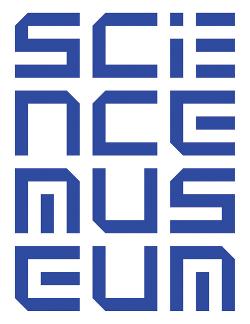
|
 |

|
The Computer Conservation Society (CCS) is a co-operative venture between BCS, The Chartered Institute for IT; the Science Museum of London; and the Museum of Science and Industry (MOSI) in Manchester.
The CCS was constituted in September 1989 as a Specialist Group of the British Computer Society (BCS). It thus is covered by the Royal Charter and charitable status of BCS.
The aims of the CCS are to
Membership is open to anyone interested in computer conservation and the history of computing.
The CCS is funded and supported by voluntary subscriptions from members, a grant from BCS, fees from corporate membership, donations, and by the free use of the facilities of our founding museums. Some charges may be made for publications and attendance at seminars and conferences.
There are a number of active Projects on specific computer restorations and early computer technologies and software. Younger people are especially encouraged to take part in order to achieve skills transfer.
The CCS also enjoys a close relationship with the National Museum of Computing.
|
Resurrection is the bulletin of the
Computer Conservation Society. Editor – Dik Leatherdale Printed by – BCS, The Chartered Institute for IT © Copyright Computer Conservation Society |